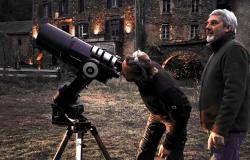Construction & Transportability
The PartyBox 120 is transportable… provided you can accommodate its 11.05 kg. As such, it does not have wheels, but a folding carrying handle. Its size (28.8 x 57 x 29.7 cm) is large but not exceptional, and goes hand in hand with very serious construction quality.
Obviously, no high-end materials here, but an entirely plastic chassis, rather dense and slightly prone to scratches (if dropped). JBL generally masters its business, since its creation is particularly stable on its supports (non-slip surface) and perfectly assembled. The only slight disappointment is that placement in a horizontal position is no longer really possible in the absence of shock absorbers/lateral feet. The whole thing is IPX4 certified (water projection), which is made possible by the presence of waterproof silicone hatches protecting the connectors.
As always with JBL PartyBoxes, the huge grid running across the facade, as well as the LED strips, have their little effect.
Wireless connectivity & broadcasting
Although a continuation of a PartyBox 110, the PartyBox Club 120 manages to improve and modernize. First observation, wired connectivity is not forgotten, far from it. Camouflaged behind one of the watertight hatches, the entrances/exits are numerous enough for versatile use. There is a microphone input in 6.35 mm jack (adjustable gain), a switchable microphone/guitar input (adjustable gain) in 6.35 mm jack, a line input in 3.5 mm jack, a USB-A port for external charging and USB key playback, not forgetting a 3.5mm jack input and output for Daisy Chain connection with other devices. Very classic for such an imposing product, charging takes place via an IEC C-7 type mains input (flat with two connectors).
So this speaker behaves like a small hub, capable of adding sound to an evening in different ways. The really impressive little extra, which shows the extreme attention to detail, comes, in our opinion, from the small light camouflaged in the connector hatch. No need to light with your smartphone’s torch.
Apart from these good old connectors, JBL embraces the concept of modern Bluetooth. Indeed, the manufacturer follows the formula launched on its new portable speakers, like the Xtreme 4, with support for Bluetooth LE Audio, including Auracast. JBL thus retains the possibility of multiple pairing, but by abandoning its in-house PartyBoost system. If this makes first the speaker is incompatible with old devices, the brand is opening up to a certain universality, the Auracast being the standard of the future. Alongside this innovation, the speaker retains the possibility of stereo association with a second model.
For the more classic Bluetooth part, the PartyBox Club 120 remains serious thanks to the presence of Google Fast Pair quick pairing, as well as multipoint. The connection is obviously very stable and the latency observed is rather low. We measured 160 ms, which is in the low average. Of course, this figure remains too high for video use without latency.
User experience
Orders
Efficient and rather intuitive, the integrated controls cover most needs. First good point, sign of a modern JBL product, the PartyBox 120 finally allows you to go back in a playlist.
The controls themselves rely on a simple element: the clickable potentiometer. Navigation is done by one, two and three clicks, and volume control by the wheel. Nothing could be simpler, especially since the current level is indicated by a small strip of LEDs. The second potentiometer is responsible for the light effects. The wheel alternates between the different light scenarios, clicking activates/deactivates this function.
In addition to the classic On/off button, the JBL accommodates a trio of Bluetooth, Auracast (equivalent to the PartyBoost button) and Bass-Boost buttons. The latter switches between three bass accentuations. Finally, and we’re talking about the most indispensable, but most fun feature, a trio of buttons are associated with audio samples. Sounds of horns, applause, crowd discontent, all customizable in the application. That is the demand of the people ?
Application
Dedicated to the brand’s festive speakers, the PartyBox app is certainly not the easiest to understand, but it stands out with a really large number of settings and little ergonomic extras.
Its strength lies in the fairly clear separation between the different functions. The sound adjustments, symbolized by equalizers, Bass-Boost mode, or even special pairings are thus stored in a dedicated tab. The same goes for everything related to the numerous lighting possibilities of the product, again organized in a separate section. After a little getting used to, everything becomes quite intuitive.
Audio
As classic as its design, the audio architecture of the JBL PartyBox Club 120 follows a certain habit of the manufacturer. Stereo, directive type, it consists of two 13.3 cm speakers with bass-reflex load (rear port) and two tweeters inclined outwards. Everything is powered by 160 W RMS amplification for a frequency response (measured at -6 dB) of 40 Hz-20 kHz.
Listening, nothing surprising… although. The speaker thus adopts a sound philosophy that we could describe as balanced, except at the bottom of the spectrum.
Even when deactivating the Bass-Boost, a fairly clear emphasis is felt in the low-mids and the beginning of the bass. This quite purring effect is relentless when it comes to bringing punch to the music. The PartyBox Club 120 is a powerful, energetic speaker, which has the good taste of not overflowing with vocals. Of course, no miracles to hope for on tracks that are already quite busy, for which the sensation of whirring quickly takes over. At least, this sound register, without being incredibly technical, retains nuance.
This nuance still fades a little going down in frequency, a range where the speaker loses its linearity, with a more sensationalist profile. The bass extension, which easily reaches 40 Hz, is obviously not done with the cleanliness of a very good subwoofer, but does not fall into a sound mush. The JBL does not try to go beyond its possibilities at this point. On the other hand, Bass-Boost modes should be avoided for those who want to stay in time. The first of the two notches, which already noticeably accentuates the low-mid-bass bump, makes the listening even heavier. As for the second, it pushes the PartyBox 120 into an ocean of excess. To have fun, but not much more…
The rest of the spectrum is more familiar, more “traditional JBL”, since it is surprisingly clean. Confident in its transducers, the brand does not fall into excess aggressiveness and does not seek to play on accentuations. Very energetic, the PartyBox Club 120 can be quite gentle by lowering the bass level (via the application’s equalizer) and/or by comparing it to calm styles. We would not recommend this product for hi-fi listening, at least not compared to classic devices like the Authentics 300, but it is not ridiculous in this exercise. The level of detail is good and the dynamics impeccable.
Conversely, the impression of stereo is very relative, as is the width of the soundstage. Some effects are clearly perceptible, but you should not expect the sounds to pass through the room from right to left. Above all, the notion of sweet spot has its importance. The inclined tweeters logically tend to be heard more as they move away from the axis of the JBL. By positioning yourself in front of one of the tweeters, the listening is drier and less precise to the ear. More than sweet spotswe would rather speak of two “worst-spots” very localized.
Finally, it is difficult not to mention the power reserve of the product. Designed for this exercise, the speaker manages to maintain its bass level up to high volumes. Above all, the distortion remains frankly moderate.
Points forts
-
Bass extension, sound power.
-
Quite balanced in the mids and highs.
-
Complete connectivity, modern connectivity (Auracast).
-
Rich and intuitive ergonomics.
-
Removable battery.
Weak points
-
Overflows in low frequencies.
-
Marked directivity, treble too present in front of the tweeters.
-
Average autonomy.
Conclusion
How does the rating work?
Largely focused on bass and sound power, the PartyBox Club 120 is more subtle than you might think. Its good sound performance, combined with advanced lighting capabilities, rich connectivity and innovative connectivity, make it a very good party speaker. With greater autonomy and less directivity, this PartyBox would score additional points.






